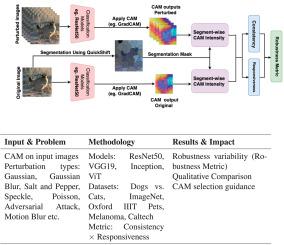评估类激活图的噪声稳健性:一个可靠模型可解释性的框架
IF 4.2
3区 计算机科学
Q2 COMPUTER SCIENCE, ARTIFICIAL INTELLIGENCE
引用次数: 0
摘要
类激活图(Class Activation Maps, CAMs)是深度学习模型中用于区域可视化的重要方法之一。然而,它们对不同噪声的稳健性仍未得到充分研究。在这项工作中,我们评估并报告了各种CAM方法对不同架构和数据集的不同噪声扰动的弹性。通过分析不同噪声类型对CAM解释的影响,我们评估了对噪声的敏感性以及数据集特征可能影响解释稳定性的程度。研究结果强调了各种cam在噪声敏感性方面的相当大的差异。我们为cam提出了一个鲁棒性度量,它捕获了两个关键属性:一致性和响应性。一致性反映了cam在不改变预测类别的输入扰动下保持稳定的能力,而响应性衡量cam对由此类扰动引起的预测变化的敏感性。该度量通过模型、不同的扰动和数据集进行经验评估,并辅以补充统计测试,以举例说明我们提出的方法的适用性。本文章由计算机程序翻译,如有差异,请以英文原文为准。

Assessing the noise robustness of Class Activation Maps: A framework for reliable model interpretability
Class Activation Maps (CAMs) are one of the important methods for visualizing regions used by deep learning models. Yet their robustness to different noise remains underexplored. In this work, we evaluate and report the resilience of various CAM methods for different noise perturbations across multiple architectures and datasets. By analyzing the influence of different noise types on CAM explanations, we assess the susceptibility to noise and the extent to which dataset characteristics may impact explanation stability. The findings highlight considerable variability in noise sensitivity for various CAMs. We propose a robustness metric for CAMs that captures two key properties: consistency and responsiveness. Consistency reflects the ability of CAMs to remain stable under input perturbations that do not alter the predicted class, while responsiveness measures the sensitivity of CAMs to changes in the prediction caused by such perturbations. The metric is evaluated empirically across models, different perturbations, and datasets along with complementary statistical tests to exemplify the applicability of our proposed approach.
求助全文
通过发布文献求助,成功后即可免费获取论文全文。
去求助
来源期刊

Image and Vision Computing
工程技术-工程:电子与电气
CiteScore
8.50
自引率
8.50%
发文量
143
审稿时长
7.8 months
期刊介绍:
Image and Vision Computing has as a primary aim the provision of an effective medium of interchange for the results of high quality theoretical and applied research fundamental to all aspects of image interpretation and computer vision. The journal publishes work that proposes new image interpretation and computer vision methodology or addresses the application of such methods to real world scenes. It seeks to strengthen a deeper understanding in the discipline by encouraging the quantitative comparison and performance evaluation of the proposed methodology. The coverage includes: image interpretation, scene modelling, object recognition and tracking, shape analysis, monitoring and surveillance, active vision and robotic systems, SLAM, biologically-inspired computer vision, motion analysis, stereo vision, document image understanding, character and handwritten text recognition, face and gesture recognition, biometrics, vision-based human-computer interaction, human activity and behavior understanding, data fusion from multiple sensor inputs, image databases.
 求助内容:
求助内容: 应助结果提醒方式:
应助结果提醒方式:


